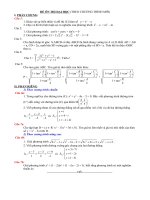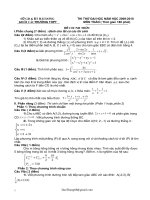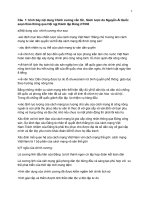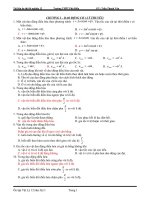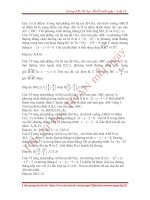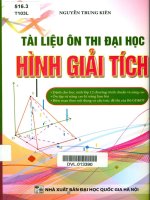Tài liệu ôn thi semantics có lời giải
Bạn đang xem bản rút gọn của tài liệu. Xem và tải ngay bản đầy đủ của tài liệu tại đây (569.63 KB, 12 trang )
SECTION 1: INTRODUCTION
Question : Distinguish SEMANTIC MEANING from PRAGMATIC MEANING. Give an example to illustrate
each.
Answer:
Semantic meaning (nghĩa ngữ nghĩa) is context-free whereas pragmatic meaning (nghĩa ngữ dụng) is contextdependent. ( note : explain context-free and context-dependent - discuss shortly other aspects
)
Ex. Tom: Do you like the wine I picked out?
Gina: It's Italian, isn't it?
The semantic meaning of “it's Italian, isn't it?" is "/s it right that the wine is made in Italy?"
The pragmatic meaning of “It’s Italian, isn't it” is "/ don^t like the wine you picked out."
( notes : provide other examples which is easier to understand)
SECTION 2: WORD MEANING
2.1 Question : What are SEMANTIC FEATURES /
/ [also SEMANTIC
PROPERTIES/
COMPONENTS] (các nét nghĩa).Give appropriate examples to illustrate your presentation.
Answer: Semantic features are the smallest units of meaning in a word.
Ex1 Child: [+human], [+young], [+male], [+innocent]
Ex2. Bachelor: [+human], [+mature], [+male], [+stay single]
2.2
A. Question : What is COMPONENTIAL ANALYSIS (sự phân tích nghĩa tố)?
Answer : In Semantics, componential analysis is "an approach to the study of meaning which analyses a word
into a set of meaning-components or semantic features." [Richards et al,1987:53]
For example, the meaning of boy may be shown as [+human], [+male] and [-adult] while that of man
may be a combination of [+human], [+male] and [+adult]. Thus, man is different from boy basically
in one primitive semantic feature: [±adult].
Generally speaking, componential analysis is applied to a group of related words which
may differ from one another only by one or two semanticfeatures. (1)
(1) explain shared features and differentiating features
B. Question : What are BINARY OPPOSITIONS (thể đối lập có-không)?
Answer : Some redundancy rules infer negative semantic features (1). Thus, semantic features are
often shown in the form of binary oppositions, which can be stated in terms of pluses and
minuses (that is, [+] and [—]):
If father is [+human], it is therefore [-inhuman];
If father is [+male], it is therefore [-female];
If father is [+mature], it is therefore [-immature];
If father is [+paternal], it is. therefore [-maternal].
(1) Notes : explain redundancy rules
2.3 Question : What is A SEMANTIC FIELD /
/ (một trường từ vựng)[note: also LEXICAL
FIELD/SET]? Give examples to illustrate your presentation.
Answer :
A semantic field [ lexical field / lexical set ] is a set of words with identifiable semantic affinities.
Ex1 The lexical/semantic field of kinship terms: father, mother, brother, sister, uncle, aunt, etc.
Ex2. The lexical/semantic field of color terms: green, blue, red, white, black, etc.
/ (ô trống từ vựng )? Give examples to
2.4 Question : What is A LEXICAL GAP /
illustrate your
presentation.
Answer : A lexical gap is the absence of a word in a particular place in a lexical field of a language.
Example:
horse
stallion
mare
? (a lexical gap)
goat
foal
billy-goat
nanny-goat kid
bull
cow
calf
2.5
A. Question : Identify REFERENT, REFERENCE and SENSE. In what ways are they different from and
related to one another?
/ (một vật sở chỉ ) is an object or an entity in the real world or in the world
of your imagination, e.g. your school, your classmates, your teacher, anything you can see in the
classroom right now, the lovely Princess in a fairy tale which you have already read, the idealistic
working conditions you have. ever dreamed of, etc. that is talked about.
Answer : A REFERENT /
The REFERENCE /
/ (sở chỉ) of a word or a linguistic expression is the relationship between
that word or expression and the thing, the action, the event, the state of affairs, etc. it refers to.
"Peter's house “(an expression in the English language)
the house that belongs to Peter (in the real world)
REFERENCE
THE SENSE /
/ (nghĩa) of a word or a linguistic expression shows the internal relationship
between that word or expression and others in the language.
Ex1. “Bachelors” means “unmarried men”
Ex2. "A dog is chasing a cat” has some sense. However, "A dog is buman” has no sense. (1)
(1) Notes : Show the relationships between words in each sentence.[dog-chase-cat]-[dog-human]
B. Question : Identify VARIABLE REFERENCE, CONSTANT REFERENCE and CO-REFERENCE.
In what ways are they different from one another?
Answer : When the same linguistic expression refers to different referents, it has VARIABLE REFERENCE
/
/ (sở chỉ không cố định).
Ex. The referent of the phrase "the'present prime minister”used in Britain in 1944 is Mr.
Churchill and in 1982 is Mrs. Thatcher.
When one linguistic expression refers to one and the same referent, it has CONSTANT REFERENCE
/
/ (sở chỉ cố định): " the sun u “the moon”, "Angola” "FIFA” " UNESCO”,
etc.
When two or more linguistic expressions share the same referent, they have CO-REFERENCE
/
/ (đồng sở chỉ).
Ex1 " The morning star' and " the evening star" both refer to the planet called "Venus."
Ex2. In a conversation about Britain in 1982, "the Prime Minister' and "the leader of the
Conservative Party share the same referent: Mrs Thatcher.
2.6 Question : Identify the difference between DENOTATION [also DENOTATIONAL
MEANING] and CONNOTATION [also CONNOTATIONAL MEANING].
Give appropriate examples to illustrate your presentation.
Answer :
• The DENOTATION /
/ (nghĩa sở thị) of a wore/is the core, central or referential meaning
of
the word found in a dictionary.The denotation of a word is usually described in terms of a set of
semantic features.
• The CONNOTATION /
/ (nghĩa liên tưởng) of a word is the additional meaning that the
word has beyond its denotative meaning. If shows people's emotions and/or attitudes towards
what the word refers to.
Ex. "Child" is denotatively described as [+human], [+young] and [±male].
Under a certain circumstance, "child" may positively be connoted as [+innocent].
Under another circumstance, "child" may negatively be connoted as [+noisy].
2.7 Identify the MULTIPLE SENSES of a lexical item.
A. Question : PRIMARY MEANING/SENSE vs. SECONDARY MEANING/SENSE
Answer : • The PRIMARY MEANING/SENSE (nghĩa nguyên cấp) of a word [lexical item] is the first meaning or
usage that the word will suggest to most people when it is said in isolation.
The primary meaning of the English noun “wing”, for instance, is "either of the pair of feathered
limbs that a bird uses to fly.
• SECONDARY MEANINGS/SENSES (nghĩa thứ cấp) of a word are tfie meanings besides its primary
meaning/sense.
The primary meaning/sense of a word is central and context-free whereas the secondary meanings /
senses of a word are peripheral and context-bound.
Thanks to the verb "plays" in "He usually plays on the wing”, for example, "wing' means "sidepart
of the playing area in football, Hockey, etc.."
B. Question : LITERAL MEANING/SENSE (nghĩa đen) vs. FIGURATIVE MEANING/SENSE (nghĩa bóng)
Answer :
The basic or usual meaning of a word is its LITERAL MEANING. For instance, "the east/west wing of a house"
means ''the east/west part of a house that projects from the main part."
The FIGURATIVE MEANING of a word creates vivid mental images to readers or listeners. In the sentence "Having a
new baby to look after has clipped her wings a bit"; "has clipped her wings” means "has
prevented her from achieving her ambition”
" Wing' is an English word that has several closely related but slightly different meanings. It is said to be
potysemous
2.8 Question : Distinguish A TABOO WORD from A EUPHEMISM.
Answer : A taboo word, a 'dirty' word, is the 'word or the linguistic expression that refers to a taboo act or
behaviour in a society, a culture or a speech community while a euphemism is the word or the
expression that replaces a taboo word or serves to avoid a frightening or unpleasant subject “pass
away”, for example, is a euphemism for die.
It is crucial to recognize that a taboo word and its euphemism share the same denotative meaning
but they differ in their connotative meanings: the taboo word has a negative connotation whereas its
euphemism has a positive connotation.
2.9 HYPONYMY
A. Question : What is HYPONYMY /
/ (quan hệ trên dưới)? Give an example to illustrate your
presentation.
Answer : HYPONYMY is a relation/a phenomenon in which the sense of a word is totally included in the
sense of another word'.
or
HYPONYMY is the relationship between each of the HYPONYM [also SUBORDINATE / SPECIFIC
LEXICAL ITEM] (i.e. the "lower" word) and its SUPERORDINATE [ also HYPERNYM / HYPERONYM
/ GENERIC LEXICAL ITEM (i.e. the "higher" word).
Example
Cook
grill
toast
boil
( = a superordinate)
fry
smoke
.........
( = hyponyms)
B. Question : Distinguish A HYPONYM from A SUPERORDINATE.
Answer :
A HYPONYM /
in the sense of another word.
A SUPERORDINATE
/ (hạ danh) is a word whose sense / the sense of which is totally included
/ (thượng danh) is a word whose sense covers all the senses
of its
hyponyms.
Example
Color
blue
red
yellow
( = a superordinate)
green
black ......... ( = hyponyms)
2.10 SYNONYMY
A Question : What is SYNONYMY /
/ (tính đồng nghĩa)?
Answer : Synonymy is a relation/a phenonomenon in which various words have different (sound and written)
forms but have the same or nearly the same meaning.
For example, the four English nouns "kind", "type”, "sort” , and "variety” are synonyms; they refer to
"a group having similar characteristics."
B Question : What are SYNONYMS /
/ (từ đồng nghĩa)?
Answer : SYNONYMS are various words which have different (sound and written) forms but which have the
same or nearly the same meaning.
For example, the two English verbs "hide' and "conceal " are synonyms; they both mean "keep
somebody/something from being seen or known about."
C. Question : What is PARTIAL SYNONYMY?
Answer : Partial synonymy /
/ (tính đồng nghĩa bộ phận) is a relation/a phenonomenon
In which a polysemous word shares one of its meanings with another word.
For example, one meaning of "deep" is synonymous with "profound' in the pair of sentences marked
(l) a-b. In other words, "deep" and "pro found” can be used interchangeably in (l)a-b. No such
interchange can be found in (2)a-b:
(l)a. You have my deep sympathy.
(1)b. You have my pro found sympathy.
(2)a. The river is very deep at this point.
(2)b. *The river is very profound at this point.
Notes : * means “this is not likely / impossible” (= trường hợp như thế này không có thực mà chỉ thí dụ như vậy
thôi )
2.11.1 ANTONYMY
A Question : What is ANTONYMY /
/ (Tính trái nghĩa)?
Answer : ANTONYMY is a relation/a phenonomenon in which two words are opposite in meaning.
/ (từ trái nghĩa)?
Answer : ANTONYMS are words that are opposite in meaning.
B Question : What are ANTONYMS /
For example, "true—false”, "big—-small" and "buy—sell" are three pairs of antonyms.
2.11.2 BINARY ANTONYMY - GRADABLE ANTONYMY - RELATIONAL ANTONYMY
A. Question : Distinguish BINARY ANTONYMY from GRADABLE ANTONYM. Give two examples to
illustrate each.
Answer :
BINARY ANTONYMY
=complementary antonym
(tính trái nghĩa lưỡng/nhị phân) is a relation /
phenomenon in which
two members of a pair ofantonyms
(a) are mutually exclusive: "not alive' is "dead'' and "not dead' is "alive
(b) cannot be used in a comparative or superlative sense:
*He is more single / more married than his brother.
(c) cannot be used in questions with "how" to ask about degrees:
*How single / How married is he ?
Thus, "alive—dead' and "married—single' are two pairs of binary antonyms.
Notes : * means “this is not likely / impossible” (= trường hợp như thế này không có thực mà chỉ thí dụ như vậy
thôi )
GRADABIE ANTONYMY /
relation/a
phenonomenon in which two members'of a pair of antonyms'.
/ (tính trái nghĩa có thang độ) is a
(a) are gradable: between "hot' and "cold' are three intermediate terms — "warm" 'tepid' and "coo/".
(b) can be used in a comparative or superlative sense: "more difficult' is "less easy'^ "wider' is " less
narrow', etc.
(c) can be used in questions with '"how" to ask about degrees:
How difficult is the test ?
Thus, "hot—cold'''and "difficult—eas'/' are two pairs of gradcble antonyms.
B. Question : What are RELATIONAL ANTONYMS /
( từ trái nghĩa nghịch
đảo)?
Answer : Relational antonymy is a relation/a phenomenon in which two members of a pair of antonyms display
symrpetrv in their meaning. The "if..., then ...'' formula can be used to test and identify relational
antonyms: if Mr. Brown is Jack's employer, then Jack is Mr. Brown's employee; if Jenny is thinner
than Msry, then Mary is fatter than Jenny; if John bought a car from Fred, then Fred sold a car to_
John; etc. Thus, "buy—self, "employer—employee', " thinner—fatter' are three pars of relational
antonyms.
2.12.1
Distinction between TRUE HOMONYMY, HOMOPHONY and HOMOGRAPHY.
A. Question : What is TRUE HOMONYMY
(tính đồng âm đồng tự) ?
Answer : TRUE HOMONYMY is a relation/a phenomenon in which various words have the same (sound
and written) form but have different meanings.
For example, classified as two true homonyms are the noun "bank” which means "a financial
institution" and the noun "bank” which means "the shore of a river”,both being pronounced
/
in RP.
B. Question : What is HOMOPHONY
(tính đồng âm) ?
Answer : Homophony is a relation/a phenomenon in which various words have the same sound form [i.e.
same pronunciation] but have different meanings and written forms.
For example, classified as two homophones are the noun " place'^ which means "a particular
area", and the noun "plaice'^ which means "a type of fish"; both being pronounced /pleis/ in RP.
C. Question : What is HOMOGRAPHY
(tính đồng tự) ?
Answer : HOMOGRAPHY is a relation/a phenomenon in which various words have the same written
form[ = spelling] but have different meanings and sound forms.
For example, classified as two homographs are the bare infinitive form "'read' /
tense form "read' /
/.
/ and the past
Consider the following table and identify antonymy, synonymy, true homonymy, homophony, and
homography via their main features.
Written form
antonymy
synonymy
true homonymy
homophony
homography
—
—
+
—
+
+: the same or nearly the same;
Ca. Question : What are TRUE HOMONYMS /
Answer :
Sound form
Meaning
—
—
+
—
—
—
—
+
+
—
—: different or opposite
/ (từ đồng âm đồng tự)?
True homonyms are various words which have the same (sound and written) form
but have different meanings.
For example, the noun "bank", which means "''a financial institution", and the noun
"bank”, which means "the shore of a river", are two true homonyms.
Cb. Question : What are HOMONYMS /
Answer :
Cc. Question : What is HOMONYMY /
Answer :
/ (từ đồng âm)?
HOMONYMS are different words which are pronounced the same, but may or may not be spelled
the same. "To", "two" and "too" homonyms because they are pronounced the same, despite their
spelling differences." [Fromkin & Rodman, 1993: 129 ]
(tính đồng âm)?
Homonymy is a relation/a phenonomenon in which different words are pronounced the same,
but may or may not be spelled the same.
For example, "know' /
/ (hove something in one's mind) and "no" /
/ {not any) are
homonyms; so are "row' /
/ (a quarrel) ond "row' /
/ (a line).
Cd. Question : Distinguish HOMOGRAPHS from HOMOPHONES.
Answer :
• HOMOGRAPHS /
(từ đồng tự) are various words which have the same written form
but have different meanings and sound forms.
For example, the verb "lead' /
/ in "Does this road lead to town?” and the noun "lead" /
/ in
"Lead is a heavy metal." are two homographs.
• HOMOPHONES
(từ đồng âm dị tự) are various words which have the same sound
Form but have different meanings and written forms.
For example, the noun "place” which refers to “a particular area", and the noun "plaice” which
refers to “a type of fish", are both pronounced /
/ in many varieties of English.
2.13
A. Question : What is POLYSEMY /
/ (quan h6/ tmh da ngma) ?
Answer : Polysemy is is a relation/a phenonomenon in which a single worc/\\os two or more slightly different
but closely related meanings.
B Question : What is A POLYSEMOUS WORD /
/ (một từ ta nghĩa)?
Answer : A polysemous word is a single word which has two or more slightly different but closely related
meanings.
For example, the noun "chip" can have the following meanings:
(i) a small piece of some hard substance which has been broken off from something larger:
a chip of wood/glass.
(ii) a small cut piece of potato which is fried for eating: Can I try one of your chips?
(iii) a ssTtd! but vitafpiece of a computer: This computer has got a faster chip than the old
one.
The three meanings are closely related because they all contain the semantic feature [+ small piece].
Ba. Question :
Compare and contrast SYNONYMY and POLYSEMY in terms of:
- number of wors in question,
- number of meanings in question,
- sense relation.
Give one example for each.
Answer :
Number of words in question
Number of meanings in question
sense relation
SYNONYMY
Two or more words
one meaning
The same or nearly the same meaning
POLYSEMY
a single word
two or more meanings
Slightly different but closely related
meanings
Notes : Examples SYNONYMY : happy – glad (two synonymous words)
POLYSEMY : wing a. part of the body of a bird or insect, used for flying
b. one of the two flat parts of a plane (wing = a polysemous word )
Bb. Question : Compare and contrast SYNONYMY and HOMONYMY in terms of:
- number of wors in question,
- number of meanings in question,
- sense relation.
Give three pairs of words as examples for homonymy and one example for synonymy.
Answer:
number of wors in question
number of meanings in question
sense relation
SYNONYMY
two or more words
one meaning
The same or nearfy the same meaning
HOMONYMY
two or more words
two or more meanings
entirely different meanings
Notes Examples
Synonymy : spaceman - astronaut
Homonymy : I – eye hour – our port ( for ships) – port ( kind of wine)
2. 14 Question : Distinguish LEXICAL AMBIGUITY “
nghĩa từ vựng)
from STRUCTURAL AMBIGUITY /
lưỡng nghĩa cấu trúc).
/ (tính lưỡng
(tính
Answer:
• A sentence is considered as structurally ambiguous when its structure permits more than
one interpretation.
For example, "on Thursday" in u Fred said that he would pay me on Thursday" may
modify either "said" or "would pay"
Fred said that he would pay me on Thursday.
Fred said that he would pay me on Thursday.
• Any ambiguity resulting from the ambiguity of a word is lexical ambiguity.
For example, "that robot is bright'”is lexically ambiguous due to the two slightly different
but closely related meanings of the polysemous word "bright” — "shining'" and
"intelligent".
2.15 Question : What is ANOMALY /
Answer:
/ (hiện tượng bất thường)?
ANOMALY is a violation of semantic rules to create nonsense.
.
For example, "that bachelor is pregnant” is semanticaliy anomalous
(bất
thường về ngữ nghĩa) because the meaning of "bachelor includes the semantic feature [+male]
/
whereas "pregnant' is [+female].
SECTION 3 : SENTENCE MEANING
3.1 PROPOSITION - SENTENCE - UTTERANCE
A. Question : What is A PROPOSITION /
Answer:
/ (mệnh đề)?
A PROPOSITION is part of the meaning of the utterance of a declarative sentence which describes
some state of affairs.
Ex: The following pair of sentences expresses the same proposition:
active
(1)a. John gave Mary a book.
passive (1)b. Mary was given a book by John.
The following pair of sentences expresses different propositions:
(2)a. George danced with Ethel.
(2)b. George didn’t dance with Ethel.
B. Question : Distinguish A PROPOSITION from A SENTENCE.
Answer: PROPOSITIONS, unlike sentences, cannot be said to belong to any particular language.
Two or more sentences in different languages can correspond to the same proposition, if
they are perfect translations of each other.
As perfect translations of each other, for example, the English sentence 'I’m cold'' and the
Vietnamese sentence "Tôi lạnh" can be said to correspond to the same proposition.
Sentences
Can be loud or quiet
—
—
Can be grammatical or not
+
—
Can be true or false
+
+
in a particular regionai accent
in a particuiar language
—
+
—
—
C. Question : Distinguish AN UTTERANCE /
(câu).
Answer:
EX.. Jane;
Steve:
Jane:
Steve:
Coffee?
Sure.
White?
Black.
(four one-word utterances')
Answer:
/ (phát ngôn) from A SENTENCE /
/
An UTTERANCE is the use by a particular speaker, on a particular occasion, for a particular purpose
piece of language, such as a sequence of sentences, or a single phrase, or even a single word.
A SENTENCE is a string of words [which are put together by the grammatical rules of a language]. Such
an ideal string of words exisis behind various realizations in utterances and inscriptions.
3.2. Question :
Propositions
"Would you like some coffee
"I'm sure to love it."
"Would you like (black coffee or) white, coffee?"
"I'd like black coffee, please."
(four complete sentences}
Utterances
Sentences
Can be loud or quiet
+
—
Can be grammatical or not
+
+
Can be true or false
+
+
in a particular regional accent
+
—
In a particular language
+
+
Distinguish AN ANALYTIC SENTENCE from A CONTRADICTION or A SYNTHETIC
SENTENCE.
An ANALITIC /
/ SENTENCE (câu phân tích) is one that is necessarily TRUE, as a
result of the senses of the words in it: "'All elephants are animals ”
A CONTRADICTION /'
/ [also.a CONTRADICTORY SENTENCE (câu
nghịch lý)
is a sentence that is necessarily FALSE as a result of the senses of the words in it: "This
animat is a vegetable"
A SYNTHETIC SENTENCE (câu tổng hợp) may be either TRUE or FALSE, depending on the
way the world is:ti Sam's wife is German!'
/ (câu mô phỏng)?
3.3 Question : What is A PARAPHRASE /
Answer:
A sentence which expresses the same proposition as another sentence is a paraphrase of
that sentence.
Ex1: "I lent that book to Jim" and "Jim borrowed that book from me" are two paraphrases.
Ex2: “John gave Mary a book" and "Mary was given a book by John" are two paraphrases.
/(sự kéo theo)?
3.4 Question : What is ENTAILMENT /
Answer:
Entailment is a relationship that applies between two sentences, where the truth of one implies the
truth of the other because of the meanings of the words involved.
There are two types of entailment:
(i) One-way entailment (sự kéo theo một chiều):
Ex: "Alfred saw a bear."
"Alfred saw an animal."
(ii) Two-way entailment (sự kéo theo hai chiều):
Ex. "Paul borrowed'a. car from Sue."
"Sue lent a car to Paul."
SECTION 4 : UTTERANCE MEANING
4.2.6 Question : Distinguish PRESUPPOSITION from CONVERSATIONAL IMPLICATURE.
Answer :
The first way:
A PRESUPPOSITION is anything the speaker assumes to be true before making the utterance while a conversational implicature
is an inference or an additional unstated meaning drawn from any conversation.
Compare:
Eg. Is the Pope Catholic?
Eg.
The above Yes-No question presupposes
that “the Pope does exist in the world.”
A: Do you like apples?
B: Is the Pope Catholic?
The above conversation implies that B does like apples.
The second way
PRESUPPOSITION
CONVERSATIONAL IMPLICATURE
Presupposition is more straightforward
and more objective. It is easily drawn
before making an utterance.
Conversational implicature-is Jess-straightforward and more
subjective/personal. It is only drawn after a conversation is
over.
Eg. Is the Pope Catholic?
The above Yes-No question presupposes
that 'the Popedoes exist in the world.'
Eg.
A: Do you like apples?
B: Is the Pope Catholic?
The above conversation implies that B does like apples.
4.3 Question : Distinguish CONVENTIONAL IMPLICATURES (hàm ngôn theo quy ước) from
CONVERSATIONAL IMPUCATURES (hàm ngôn hội thoại).
Answer : Unlike conversational implicatures, CONVENTIONAL IMPLICATURES don't have to occur in
conversation, and they don't depend on special contexts for their interpretation.
Like lexical presuppositions, conventional implicatures are associated with specific words and result
in additional conveyed meaning when those words are used.
The utterance "Linda suggested black. But I chose white" may implicate that the speaker does
something in contrast to what has been suggested.
4.4.5 Question : Distinction between LOCUTION, ILLOCUTION and PERLOCUTION
Answer : The LOCUTION of an utterance is producing an utterance, which is "a meaningful inguistic
expression" [Jule, 1996: 48].
The ILLOCUTlON of an utterance is using an utterance "to perform a function"
[Richards etaU985:168].
The PERLOCUTiON of an utterance is "causing a certain effect on the hearer or others." [Hurford
and Heasley, 1984: 243]
For example, the locution, illocution, and perlocution analysis can be used to analyse the italicized
utterance in the following dialogue.
Son: “Can I go out for a while. Mum?”
Mother:”You can play outside for half an hour.?
The LOCUTION of the utterance is the mother's uttering the words 'You can play outside for half an
hour which can be semantically paraphrased as "You have my permission to go out for a while”
with you referring to the son.
The ILLOCUTSON of the utterance is the mother's using the utterance to give permission.
The PERLOCUTION of the utterance is Us effect on the son, who races out of the room picking up
his football on the way.
4.4.6 Question : What are FELICITY CONDITIONS (điều kiện hữu hiệu)?
Answer : Felicity conditions are the conditions which must be fulfilled for a speech act to be satisfactorily
performed
The felicity conditions necessary for a promise
(a) A sentence is used which states a future act of the speaker.
(b) The speaker has the ability to do the act.
(c) The hearer prefers the speaker to do the act rather than not to do it.
4.5 Question : Distinguish PERFORMATIVES from CONSTATIVES.
Answer : A PERFORMATIVE /
/ (câu hành ngôn) performs soms act and simultaneously
describes
that act.
For example, "I PROMISE to repay you tomorrow” both describes a promise and is a promise.
Therefore, it is a performative.
A CONSTATIVE /konstetiv/ (câu nhận định) asserts something that is either true or false.
For example, "John PROMISED +to repay me tomorrow" describes a promise, but it is not itself a
promise. It is therefore not a performative but a constative.
4.2.4 Question : What is THE CO-OPERATIVE PRINCIPLE (nguyên tắc hợp tác)?
Answer : The CO-OPERATIVE PRINCIPLE is a basic principle governing conversation. It consists of four
basic CONVERSATIONAL MAXIMS (phương châm hội thoại):
1) The maxim of RELEVANCE: what -we say should be relevant.
2) The maxim of QUALITY: what we say should be true.
3) The maxim of QUANTITY: what we say should be brief.
4) The maxim of CLARITYA/IANNER: what we say should be clear.
In fact, these conversational maxims are not always observed.
4.6. THE POLITENESS PRINCIPLE
A. Question : What is THE POLITENESS PRINCIPLE (nguyên tắc lịch sự)? In what way is it related to THE COOPERATIVE PRINCIPLE?
Answer : The principle of politeness consists of:
• THE APPROBATION MAXIM (phương châm tán đồng): Minimize dispraise of the other;
maximize praise of the other.
• THE TACT MAXIM (phương châm xử trí ): Minimize the cost to the other; maximize the
benefit to the other.
Accordingly, some utterances seem more polite than others:
(1)"Clean up the kitchen floor" (the least polite)
(2) “Pass the salt"
(3) "Have some more cake" (the most polite)
The politeness principle and the co-operative principle are often in conflict with each other.
Language users must be consciously aware of this conflict and flexibly apply both of the
principles in face-to-face conversation.
B. Question : Identify the relationship between POLITENESS and INDIRECTNESS.
Answer : Politeness and indirectness are closely related to each other. In the following dialogue, the
indirect negative response is more polite than the direct one.
Tom: Do you like the wine I picked out?
Gina: (a) Not really. (+ direct, + negative)
(b) It's Italian, isn't it? (- direct, + negative)
4.7 Question : What is DEIXIS /
/(trực chỉ)?
Answer : DEIXIS refers to a word/phrase which directly relates an utterance to a time, place or person.
Deixis consists of three semantic notions.
(i) Person deixis ( trực chỉ người): In this family, we rarely smoke or drink.
(ii) Space deixis (trực chỉ trong không gian): I’m over here.
(iii) Time deixis (trực chỉ về thời gian): Tomorrow is a holiday.
Question : What is A SPEECH EVENT (sự kiện ngôn từ)?
Answer : A speech event is a particular instance when people exchange speech:
Daughter: Mum, where's my red jumper?
Mother: Bottom drawer in your bedroom.
Daughter: Right, I'll have a look.
The components of this speech event are its setting, participants, participants' role relationships,
message, key, and channel.

